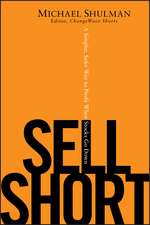Handbook of Alternative Assets 2e
Autor MJP Ansonen Limba Engleză Hardback – 18 sep 2006
Preț: 495.03 lei
Preț vechi: 538.08 lei
-8% Nou
Puncte Express: 743
Preț estimativ în valută:
94.74€ • 98.54$ • 78.21£
94.74€ • 98.54$ • 78.21£
Carte disponibilă
Livrare economică 24 martie-07 aprilie
Livrare express 08-14 martie pentru 116.43 lei
Preluare comenzi: 021 569.72.76
Specificații
ISBN-13: 9780471980209
ISBN-10: 047198020X
Pagini: 720
Ilustrații: Illustrations
Dimensiuni: 152 x 229 x 38 mm
Greutate: 1.18 kg
Ediția:2nd Edition
Editura: Wiley
Locul publicării:Hoboken, United States
ISBN-10: 047198020X
Pagini: 720
Ilustrații: Illustrations
Dimensiuni: 152 x 229 x 38 mm
Greutate: 1.18 kg
Ediția:2nd Edition
Editura: Wiley
Locul publicării:Hoboken, United States
Public țintă
Investment professionals, portfolio managers, and those seeking CAIA certification.Cuprins
Descriere
This fully updated revision examines the five major classes of alternative assets: hedge funds, private equity, commodity futures, managed futures, and credit derivatives. These asset classes provide sources of risk and return distinct from the traditional asset classes of stocks and bonds.



















